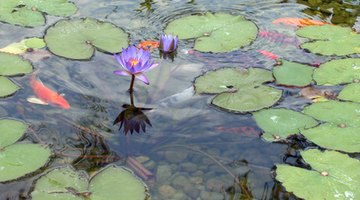Homemade Bio Balls Filter Media
Bio-balls filter media is any kind of material that goes into a pond filter used to promote the growth of beneficial bacteria in freshwater ponds. These bacteria colonies keep the ammonia and nitrates from building to unsafe levels so the fish and plants stay healthy. Materials that make the best bio-balls media have a lot of surface area for the bacteria to grow on and low packing density so there is more space for bacterial colonies to thrive. You can make homemade bio-balls using nylon scrubber pads for a cheap and effective alternative to commercially available products.

Step 1
Cut nylon scrubber pads into a variety of little blocks, between 1 to 3 inches in length. Make squares and rectangles and triangles in various sizes. The assortment of shapes gives beneficial bacteria colonies more surface area to grow inside the fibrous scrubbing material.
Step 2
Replace any current bio filter material with homemade nylon scrubber bio-balls. Changing the media is completely safe if you are not satisfied with the performance of your current filtration system. Conventional bio filter materials such as lava rocks, plastic balls, polyethylene beads, sponges and PVC material are less effective than nylon bio-balls because they are heavier, take up more space and are harder to maintain than the nylon shapes.
Step 3
Drop the blocks of nylon loosely into the pond filtration system. The blocks should be able to move freely inside the filter as water flows past them. The bacterial colonies consume organic waste matter and need to be able to release healthy byproducts back into the pond water.
Step 4
Add the prescribed amount of healthy pro-biotic bacteria to the filtration system as specified by the pro-biotic manufacturer. It can take 4 to 8 weeks to reach a healthful balance. Let the sunlight promote bacterial growth by keeping the filter uncovered.
Step 5
Plant a variety of pond flora, including hyacinth and taro. Plant life in the pond will cut down on the growth of algae and keep the water clear, allowing the bacteria in the bio-balls to do a more effective job.
References
Writer Bio
Barry Index lives in Los Angeles where he has been writing about writing since 1998. Recent freelance activities have brought his work to wider audiences through FictionAnitdote.com and several other writer-enthusiast sites. He received his Bachelor of Arts degree in English from California State University, Northridge.
Photo Credits
- koi pond image by MPH from Fotolia.com
More Articles
- How to Remove Weeds From Ponds With a Rake Pulled by a Tractor
- How to Kill Seaweed in a Pond
- How to Reset the Filter on a Daewoo Refrigerator
- How Can I Get Rid of Odor Coming From the Sprinklers of an Aerobic Treatment System?
- Guidelines on Building Ponds in Arkansas
- How to Clean Pentair FNS Plus Pool Filters



